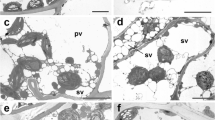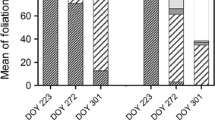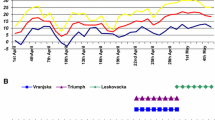Abstract
Sugar complements were analysed in extracts from leaves of desiccation tolerant species in the angiosperm families Cyperaceae, Gesneriaceae, Liliaceae, Poaceae and Velloziaceae. Total sugar content was higher in live air-dry leaves of all desiccation tolerant species (except the grass Eragrostiella nardoides; 22 µmoles/g dw) than in the dead air-dry leaves of the desiccation sensitive grass Sporobolus pyramidalis (36 µmoles/g dw). Sucrose contents rose to high levels (40–98 µmoles/g dw) in live air-dry leaves of all species (except the grass Eragrostiella nardoides in which it rose to only 11 µmoles/g dw) to become the predominant sugar. Glucose and/or fructose contents frequently were lower after leaf drying but usually these were the sugars of next highest contents in live air-dry leaves. Contents of raffinose (that has been postulated to reduce sucrose crystallization) rose to c. 10% of sucrose contents in air-dry leaves of most desiccation tolerant species (but only c. 4% in Tripogon jacquemontii) compared with c. 2% of sucrose contents in the sensitive grass S. pyramidalis. Trehalose (a rare sugar in seed-plants) was present in all but one desiccation tolerant species (Xerophyta villosa) but only in minor amounts. The results are consistent with the views that sugars play a protective role during drying of desiccation tolerant plants in general but that other factors are also involved indesiccation tolerance, that in desiccation tolerant angiospermae sucrose is generally the predominant protective sugar and that raffinose and trehalose may supplement the role of sucrose.
Similar content being viewed by others
References
Adams RP, Kendall E and Hartha KK (1990) Comparison of free sugars in growing and desiccated plants of Selaginella lepidophylla. Biochem System Ecol 18: 107-110
Albini FM, Murelli C, Patritti G, Rovati M, Zienna P and Finzi P (1994) Low-molecular weight substances from the resurrection plant Sporobolus stapfianus. Phytochem 37: 137-142
Bianchi G, Gamba A, Limiroli R, Pozzi N, Elster R, Salamini F and Bartels D (1993) The unusual sugar composition in leaves of the resurrection plant Myrothamnus flabellifolia. Physiol Plantarum 87: 223-226
Bianchi G, Gamba A, Murelli C, Salamini F and Bartels D (1991) Novel carbohydrate metabolism in the resurrection plant Craterostigma plantagineum. Plant J 1: 355-359
Bianchi G, Gamba A, Murelli C, Salamini F and Bartels D (1992) Low molecular weight solutes in desiccated and ABA treated calli and leaves of Craterostigma plantagineum. Phytochem 31: 1917-1922
Bianchi G, Murelli C, Bochicchio A and Vazzana C (1991) Changes in low-molecular weight substances in Boea hygroscopica in response to desiccation and rehydration. Phytochem 30: 461-466
Caffrey M, Fonesca V and Leopold AC (1988) Lipid-sugar interactions. Relevance to anhydrous biology. Plant Physiol 86: 754-758
Colaço CALS, Smith CJS, Sen S, Roser DH, Newman Y, Ring S and Roser BJ (1994) The chemistry of protein stabilization by trehalose. In Cleland JL and Langer R (eds) Formulation and delivery of proteins and peptides, pp 222-240. Washington, DC: Amer Chem Soc
Colaço C, Sen S, Thangavelu M, Pinder S and Roser B (1992) Extraordinary stability of enzymes dried in trehalose: simplified molecular biology. Bio/Technology 10: 1007-1011
Crowe JH, Hoekstra FA and Crowe LM(1992) Anhydrobiosis. Annu Rev Physiol 54: 579-599
Drennan PM, Smith MT, Goldsworthy D and van Staden J (1993) The occurrence of trehalose in the leaves of the desiccation-tolerant Angiosperm Myrothamunus flabellifolius Welw. J Plant Physiol 142: 493-496
Gaff DF (1971) The desiccation tolerant higher plants of southern Africa. Science 174: 1033-1034
Gaff DF(1977) Desiccation tolerant vascular plants of southern Africa. Oecologia 31: 95-105
Gaff DF (1980) Protoplasmic tolerance of extreme stress. In: Turner NC and Kramer PJ (eds) Adaptation of Plants to Water and High Temperature Stress, pp 207-230. New York: John Wiley and Sons
Gaff DF and Bole PV (1986) Resurrection grasses in India. Oecologia 71: 159-160
Gaff DF and Churchill DM (1976) Borya nitida Labill. - an Australian species in the Liliaceae with desiccation-tolerant leaves. Aust J Bot 24: 209-224
Gaff DF and Ellis RP (1974) Southern African grasses with foliage that revives after dehydration. Bothalia 11: 305-308
Gaff DF and Loveys BR (1993) ABA levels in drying plants of a resurrection grass. Trans Malaysian Soc Plant Physiol 3: 286-287
Heber U and Santarius KA (1964) Loss of adenosine triphosphate synthesis caused by freezing and its relationship to frost hardiness problem. Plant Physiol 39: 712-719
Kaiser K, Gaff DF and Outlaw WH Jr (1985) Sugar contents of leaves of desiccation-sensitive and desiccation-tolerant plants. Naturwissenschaft 72: 608-609
Roser B (1991) Trehalose, a new approach to premium dried foods. Trends in Food Science &; Technol 12: 166-169
Santarius KA(1969) Der Einfluss von Elektrolyten auf Chloroplasten beim Gefrieren und Trocknen. Planta 89: 23-46
Schwab KB and Gaff DF (1986) Sugar and ion contents of drought tolerant plants under water stress. J Plant Physiol 125: 257-265
Schwab KB and Heber U (1984) Thylakoid membrane stability in drought-tolerant and drought-sensitive plants. Planta 161: 37-45
Suan R, Cuevas A, Valpuesta V and Reid MS (1991) Arbutin and sucrose in leaves of the resurrection plant Myrothamnus flabellifolia. Phytochem 30: 2555-2556
Sun WQ, Irving TC and Leopold AC (1994) The role of sugar, vitrification and membrane phase transiition in seed desiccation tolerance. Physiol Plantarum 90: 621-628
Walter H (1931) Die Hydratur der Pflanze. Gustav Fischer: Jena
Webb SJ (1965) Bound Water in Biological Integrity. Spring-field, Illinois: Charles C Thomas
Wettlaufer SH and Leopold AC (1991) Relevance of Amadori and Maillard reactions to seed deterioration. Plant Physiol 89: 977-981
White E and Towers GHN (1967) Comparative biochemistry of the Lycopods. Phytochem 6: 663-667
Williams RJ and Leopold AC (1989) The glassy state in corn embryos. Plant Physiol 89: 977-981
Author information
Authors and Affiliations
Rights and permissions
About this article
Cite this article
Ghasempour, H., Gaff, D., Williams, R. et al. Contents of sugars in leaves of drying desiccation tolerant flowering plants, particularly grasses. Plant Growth Regulation 24, 185–191 (1998). https://doi.org/10.1023/A:1005927629018
Issue Date:
DOI: https://doi.org/10.1023/A:1005927629018




